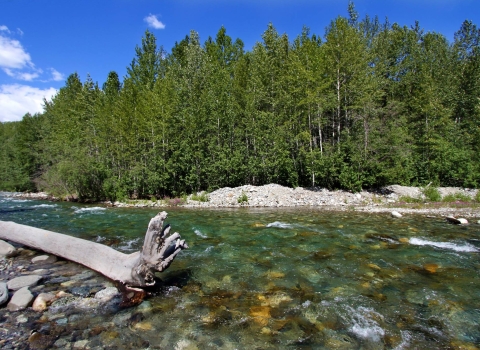The Biden-Harris administration today released the President’s Budget for Fiscal Year 2025, including a proposed $1.9 billion in current appropriations, to fund the U.S. Fish and Wildlife Service. The budget funds the Service’s resource management and conservation programs and supports the administration’s priorities. The budget also contains an additional $2 billion available under permanent appropriations, most of which is provided directly to states for fish and wildlife restoration and conservation.
The budget request promotes strategic investments to tackle climate change climate change
Climate change includes both global warming driven by human-induced emissions of greenhouse gases and the resulting large-scale shifts in weather patterns. Though there have been previous periods of climatic change, since the mid-20th century humans have had an unprecedented impact on Earth's climate system and caused change on a global scale.
Learn more about climate change impacts on Service trust resources, conserve American lands and wildlife, reconnect Americans with the outdoors, enable economic development, and create good-paying job opportunities.
“The President’s budget for the Service helps us prepare for the next century of conservation delivery, supporting our values-guided decision-making to achieve our conservation mission,” said Service Director Martha Williams. “These funds provide critical support that fosters respectful relationships with our partners and leverages our collaborative efforts to address complex conservation challenges, such as biodiversity loss and climate change.”
Budget support under the President’s Investing in Americaagenda is also provided through continued funding from the Bipartisan Infrastructure Law Bipartisan Infrastructure Law
The Bipartisan Infrastructure Law (BIL) is a once-in-a-generation investment in the nation’s infrastructure and economic competitiveness. We were directly appropriated $455 million over five years in BIL funds for programs related to the President’s America the Beautiful initiative.
Learn more about Bipartisan Infrastructure Law and the Inflation Reduction Act. The Great American Outdoors Act Great American Outdoors Act
This landmark conservation law, enacted in 2020, authorizes the use of up to $1.9 billion a year in energy development revenues for five years for needed maintenance to facilities and infrastructure in our wildlife refuges, national parks, forests, recreation areas and American Indian schools.
Learn more about Great American Outdoors Act provides the Service with additional support, including up to $95 million in FY 2025 for deferred maintenance projects within the National Wildlife Refuge System.
The FY 2025 budget proposal will provide the Service $1.7 billion for Resource Management, the Service’s principal operating account. This includes:
- $60.8 million in additional funding for the National Wildlife Refuge System. This funding will help refuges improve their ability to conserve species and habitats and provide visitors more opportunities to explore natural areas. The budget funding will also expand opportunities for Americans in urban communities to connect with the outdoors and contribute to conservation.
- $68.1 million for the Partners for Fish and Wildlife Program and $14.6 million for the Coastal Program. These citizen-centric programs align with the objectives of the America the Beautiful Initiative by working collaboratively with partners to restore, enhance and protect habitat for priority federal trust species. The projects provide other benefits to local communities by enhancing drought resistance through water conservation projects, creating resilience to wildfire, and supporting habitat and migration corridors for game and other plants and animals of cultural significance.
- $338.2 million for the Ecological Services program to support conservation of species listed under the Endangered Species Act and work to prevent at-risk species from becoming further imperiled. The ESA has been highly effective and credited with saving 99% of listed species from extinction. Within this total is $146.6 million for Planning and Consultation activities to support environmental reviews of infrastructure projects that help ensure responsible development. In response to significantly increased demand for these reviews resulting from the Bipartisan Infrastructure Law investment, the budget also proposes legislative language to avoid bottlenecks by making it easier for federal agencies to support this work.
- $37.9 million for Science Applications. The program supports science partnerships with states, Tribes, industry, local communities and other stakeholders to design and implement conservation and habitat management strategies that support the development of landscape conservation objectives such as biodiversity, adaptation and resilience. By weaving together conservation design principles and local conservation blueprints, the collaborations increase coastal resilience, mitigate desertification, control invasive species invasive species
An invasive species is any plant or animal that has spread or been introduced into a new area where they are, or could, cause harm to the environment, economy, or human, animal, or plant health. Their unwelcome presence can destroy ecosystems and cost millions of dollars.
Learn more about invasive species , and reduce the impacts of wildfires. - $239.3 million for the Fisheries and Aquatic Conservation Program. The program carries out aquatic resource conservation work through a nationwide network of more than 150 facilities that includes national fish hatcheries, fish and wildlife conservation offices, fish health centers, and fish technology centers. These facilities are neighbors to communities across the nation, providing the American public a variety of long-standing outdoor opportunities to see and learn about fish and aquatic resources and enjoy nature. The 2025 budget includes $18.6 million to provide for fish passage fish passage
Fish passage is the ability of fish or other aquatic species to move freely throughout their life to find food, reproduce, and complete their natural migration cycles. Millions of barriers to fish passage across the country are fragmenting habitat and leading to species declines. The U.S. Fish and Wildlife Service's National Fish Passage Program is working to reconnect watersheds to benefit both wildlife and people.
Learn more about fish passage improvements to restore native fish habitat and reconnect fish migration routes.
For more information on the President’s FY 2025 Budget, please visit: https://www.whitehouse.gov/omb/budget/.



